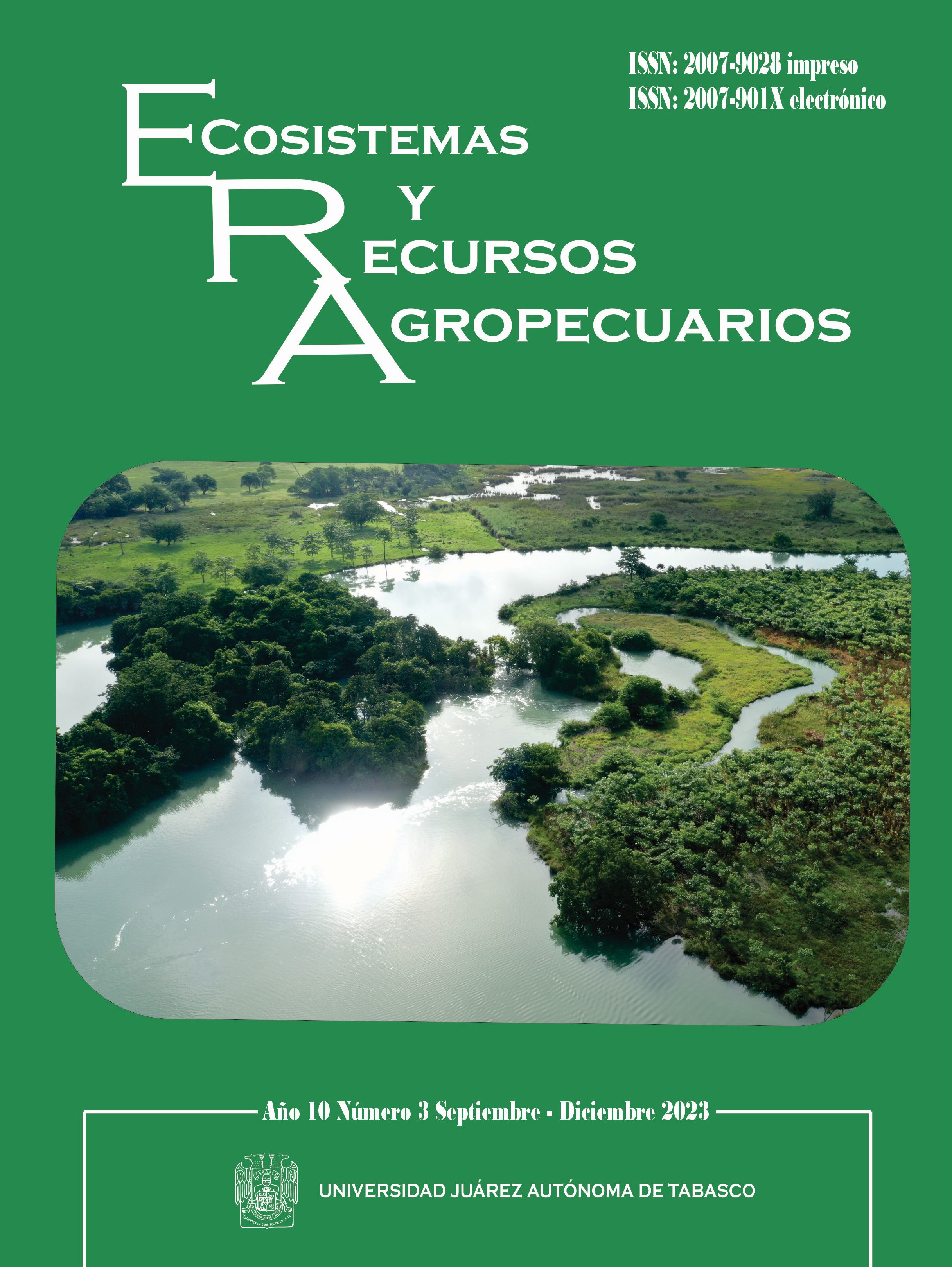Pollen collection, colony development and environmental parameters in Scaptotrigona hellwegeri bees (Hymenoptera: Meliponini)
DOI:
https://doi.org/10.19136/era.a10n3.3687Keywords:
Scaptotrigona hellwegeri, pollen collection, weight gain, environmental parameters, growth colonies.Abstract
Pollen collection, the influence of environmental parame- ters and weight gain in Scaptotrigona hellwegeri colonies were studied. The entry of bees with pollen was recorded for 5 min every hour during the day, biweekly for 9 months. The starting and ending time and period of the day during which, the bees collected more pollen were determined. The environmental parameters were related to pollen collection and the colonies were weighed monthly. The starting and ending times of pollen collection were at 8:00 a.m. and 9 p.m., with a collection peak between 11:00 a.m. and 5:00 p.m. Temperature, light intensity, relative humidity, and wind speed had a moderate relationship with collection activity. The colonies slightly increased in weight in January, and a higher collection of pollen was observed in January and May.
Downloads
References
Ayala R (1999) Revisión de las abejas sin aguijón de México (Hymenoptera: Apidae: Meliponini). Folia Ento- mológica Mexicana 106: 1-123. Doi: 10.3390/insect9040138
Basari N, Ramli S, Khairi N (2018) Food reward and distance influence the foraging pattern of stingless bee, Heterotrigona itama. Insects 9: 138.
Bharath MP, Chinniah C, Jayaraj J, SureshK, Balamohan TN, Vellaikumar S (2019) Foraging performance of stingless bee, Tetragonula iridipennis Smith (Hymenoptera: Apidae) during winter season in Madurai, Tamil Nadu. International Journal of Chemical Studies 7: 360-364.
Bucher S, König P, Menzel A, Migliavacca M, Ewald J, Römermann C (2018) Traits and climate are associated with first flowering day in herbaceous species along elevational gradients. Ecology Evolution 8: 1147-1158
CEAEJ (2014) Ficha Técnica Hidrológica del municipio de Autlán de Navarro Jalisco. Comisión Estatal del Agua del Estado de Jalisco. Jalisco, México. https://www.ceajalisco.gob.mx/doc/fichas_hidrologicas/region10/ autlan%20de%20navarro.pdf. Fecha de consulta: 2 de enero de 2023.
CONABIO-ECOSUR (2018) Las abejas sin aguijón y su cultivo en Oaxaca, México con catálogo de especies. Primera edición. Comité Editorial de El Colegio de la Frontera Sur. México, México. 135p
Contreras-Escareño F, Becerra-Guzmán FDJ, Echazarreta-González C (2005) Apicultura: panorámica de Jalisco. 1er ed. Editorial Amate. México, México. 205p
Contreras-Escareño F, Becerra-Guzmán FJ (2008) Diversidad de las abejas sin aguijón en dos comunidades de la Sierra de Manantlán, Jalisco, México. Apitec 8: 15.
Crall JD, Chang JJ, Oppenheimer RL, Combes SA (2017) Foraging in an unsteady world: bumblebee flight performance in field-realistic turbulence. Interface Focus 1: 20160086. DOI: 10.1098/rsfs.2016.0086.
Gennari G (2019) Manejo racional de las abejas nativas sin aguijón (ANSA). Primera edición. Ediciones INTA. Buenos Aires, Argentina. 46p.
Glaum P, Wood TJ, Morris JR, Valdovinos F (2020) Phenology and flowering overlap drive specialization in pollinator networks. Cold Spring Harbor Laboratory. bioRxiv. DOI: 10.1101/2020.09.08.287946
González-Acereto JA (2012) La importancia de la meliponicultura en México, con énfasis en la Península de Yucatán. Bioagrociencias 5: 34-41.
IIEG (2021) Autlán de Navarro Diagnóstico del municipio. Instituto de Información Estadística y Geográfica el Estado de Jalisco. Gobierno del Estado de Jalisco. Jalisco, México https://iieg.gob.mx/ns/wp-content/uploads/ 2022/01/Autl%C3%A1n-de-Navarro-1.pdf. Fecha de consulta: 5 de enero de 2023.
Khalifa S, Elshafiey E, Shetaia A, El-Wahed A, Algethami A, Musharraf S, AlAjmi M, Zhao C, Masry S, Abdel- Daim M, Mohammed F, Guoyin K, Yahya A, Mokhtar B, Mohamed A, Hesham R (2021) Overview of Bee Pollination and Its Economic Value for Crop Production. Insects 12: 688. DOI: 10.3390/insects12080688.
Klein S, Pasquaretta C, He XJ, Clint P, Eirik S, Jean-Marc D, Andrew B, Mathieu L (2019) Honey bees increase their foraging performance and frequency of pollen trips through experience Scientific Report 9: 6778. DOI: 10.1038/s41598-019-42677-x.
Martins AE, Camargo MG, Morellato LPC (2021) Flowering Phenology and the Influence of Seasonality in Flower Conspicuousness for Bees. Frontiers Functional Plant Ecology 11: 594538 DOI: 10.3389/fpls.2020.594538.
Minahan D, Brunet J (2018) Strong Interspecific Differences in Foraging Activity Observed Between Honey Bees and Bumble Bees Using Miniaturized Radio Frequency Identification (RFID). Frontiers in Ecology and Evo- lution 6: 156. DOI: 10.3389/fevo.2018.00156.
Mohammad SM, Mahmud-Ab-Rashid NK, Zawawi N (2021) Stingless bee-collected pollen (Bee Bread): Chemical and microbiology properties and health benefits. Molecules 11: 957. DOI: 10.3390/molecules26040957.
Neumüller U, Burger H, Schwenninger HR, Hopfenmüller S, Krausch S, Weiß K, Ayasse M (2021) Prolonged blooming season of flower plantings increases wild bee abundance and richness in agricultural landscapes. Biodiversity and Conservation 30: 3003-3021.
Pallant J (2020) SPSS Surival Manual: A step by step guide to data analysis using IBM SPS. Edición 7th ed. Routledge. London, UK. 378p.
Pérez-Sato J, Salazar-Vargas H, Hidalgo-Contreras, Real-Luna N, Debernardi-De La Vequia H, De la Rosa- Santamaría R (2021) Efecto del modelo y material de construcción de la caja y recubrimiento de los panales de cría en la termorregulación y desarrollo de colonias de Scaptotrigona mexicana. Revista Mexicana de Ciencias Pecuarias 12: 437-452.
Quezada-Euán J (2005) Biología y uso de las abejas sin aguijón de la península de Yucatán, México (Hy- menoptera, Meliponini). Primera edición. UADY. Yucatán, México. 112p
Reyes-Carrillo JL, Cano-Ríos P (2000) Manual de polinización apícola: la polinización de los cultivos por abejas. Primera Edición. Secretaría de Agricultura, Ganadería, Desarrollo Rural, Pesca y Alimentación. México, México. 52p.
Rodrigues C, Ferasso D, Mossi AJ, Coelho G (2020) Pollen resources partitioning of stingless bees (Hymenoptera: Apidae) from the southern Atlantic forest. Acta Scientiarum 42: 1-9. DOI: 10.4025/actascibiolsci.v42i1.48714.
Shanahan M, Guzmán DM (2017) Manual de meliponicultura básica. Primera edición. Colegio de la Frontera Sur. San Cristóbal de Las Casas, México. 53p
Soares KO, Lima MV, Evangelista-Rodrigues A, Silva AAF, Silva FJDA, Lima AIB, Da Costa CRG (2019) Factors influencing the foraging behavior of Trigona spinipes (Apidae, Meliponinae). Biological Rhythm Research 52: 1109-1119.
Souza-Junior J, Queiroz JP, Linhares CM (2019) Influence of the thermal environment on the stingless bee foraging activity: A mini-review. Journal of Animal Behaviour and Biometeorology 7: 176-178.
Uthoff C, Ruxton G (2022) Local weather conditions affect forager size and visitation rate on bramble flowers (Rubus fruticosus) in bumble bees (Bombus spp). Journal of Insect Behavior 35: 17-30.
Vaidya C, Fitch G, Martinez G, Oana AM, Vandermeer J (2023) Management practices and seasonality affect stingless bee colony growth, foraging activity, and pollen diet in coffee agroecosystems. Agriculture, Ecosys- tems. 353: 108552. DOI: 10.1016/j.agee.2023.108552.
Downloads
Published
Issue
Section
License
Copyright (c) 2023 Ecosistemas y Recursos Agropecuarios

This work is licensed under a Creative Commons Attribution-NonCommercial-ShareAlike 4.0 International License.
Aviso de copyright
Los autores que se envían a esta revista aceptan los siguientes términos:
una. Los autores conservan los derechos de autor y garantizan a la revista el derecho a ser la primera publicación del trabajo con una licencia de atribución de Creative Commons que permite a otros compartir el trabajo con un reconocimiento de la autoría del trabajo y la publicación inicial en esta revista.
B. Los autores pueden establecer acuerdos complementarios separados para la distribución no exclusiva de la versión del trabajo publicado en la revista (por ejemplo, en un repositorio institucional o publicarlo en un libro), con un reconocimiento de su publicación inicial en esta revista.
C. Se permite y se anima a los autores a difundir su trabajo electrónicamente (por ejemplo, en repositorios institucionales o en su propio sitio web) antes y durante el proceso de envío, ya que puede conducir a intercambios productivos, así como a una cita más temprana y más extensa del trabajo publicado. (Consulte El efecto del acceso abierto).


